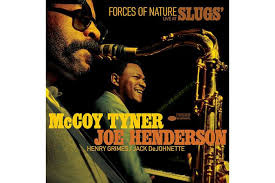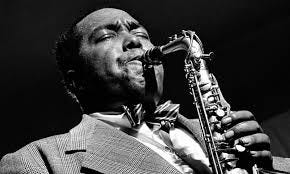Kings of Indoor Fireworks
Provocative (and context-rich) reissues from McCoy Tyner and Joe Henderson, Elvis Costello, Joe Cuba Sextet and Charlie Parker
We talk a lot about the pace of Internet-mediated life. The relentlessness of it. The way it fractures attention. Manufactures distraction. The demands it makes on us every day: Before we’re citizens, before we’re even humans, we’re avatar-tagged consumers, in the crosshairs of the endless and undifferentiated barrage of pitches, managing passwords and junk we never asked for.
The randomized undifferentiated aspect of present reality became vividly clear for me within the first tumultuous minute of “In ‘N Out,” from a previously unreleased set called Forces of Nature that Blue Note is releasing this week. Recorded live at the NYC club Slugs’ in 1966, it features pianist McCoy Tyner, saxophonist Joe Henderson, bassist Henry Grimes and drummer Jack DeJohnette. (The entire work is not available to stream yet, but the above “Isotope” is similar in spirit.)
This is an artifact from an alien time, when attention could be a laser. The quartet roars through “In ‘N’Out” for nearly 27 minutes, at an impressively brisk tempo that’s chopped to fine bits by the then-24 year old DeJohnette. By every metric, the music is relentless. There’s flamethrowing going on, and some technical wizardry, and also moments when the four become ensnared in tornado-like weather – locked in a centrifugal swirl of their own creation that they might not be able to control. That they don’t necessarily try to control.
Don’t listen just for the thundering chords or inspiring technique – listen for the masterfully sustained intensity. It’s chaotic, yet it’s the polar opposite of the Internet-accelerated splintering of order. To operate at this level demands something more than chaos management skills: It requires superlative discipline of focus. From distance, the music sounds forever teetering on the downside of frenzy, but as you track what each player is doing, you begin to pick up what might be called an elevated calm. These people are playing hard, certainly, but they’re also breezing through an ordinary set in a club. They’re operating at a clip that’s countless notches above the casual browse. The pace of the music is like a roaring river; as amazing musician-scribes like Vinnie Sperrazza noted recently, this artifact seems galvanically exotic (superhuman?) now, in comparison to just about everything timestamped 2024.
And yet this was a familiar ethos in 1966. What transpired on the Slug’s bandstand for a week was the fruit of shared ninja concentration – as practiced by musicians who routinely brought this focused intensity to the everchanging challenges of the improvisational moment. As DeJohnette said in the liner notes: “This recording represents a time and period where musicians were really playing, intensely searching and experimenting with new things. It was a highly creative time then.”
***
Joe Cuba Sextet: Vagabundeando!/Hangin’ Out
Sometimes the origin story of a success is written years before audiences start paying attention.
That’s the case with the legendary Puerto Rican vocalist Cheo Feliciano, and the records he made in the late ‘50s and ‘60s as part of the Joe Cuba Sextet. Most salsa fans know Feliciano’s work for Fania in the 1970s – among his hits are dancefloor classics (“Anacaona”) and lush boleros (“Amada Mia,” from his 1980 smash Sentimiento Tu). For a while there, his was the voice of romantic salsa.
But these Joe Cuba sides, which are among the Fania titles being restored by Craft Recordings, are wonderfully engaging, not to be missed by Feliciano obsessives. They feature a lean group pursuing a sophisticated jazz-tinged sound that would morph in several directions as the ‘60s progressed. The orchestrations on Vagabundeano!/Hangin’ Out are a direct line to Feliciano’s later work, while the vocalist’s ad-libs exude the same warmth and rhythmic exactitude that other bandleaders, Eddie Palmieri among them, prized so highly.
Vagabundeando!, from 1964, was Cuba’s debut for the Fania sublabel Tico. It’s a blithe confection that has long needed an audio upgrade. Its effortlessly grooving cha-chas and dance tunes are followed by understated ballads and a few odd teen-idol knockoffs sung in English by the group’s other vocalist, Jimmy Sabater. Feliciano’s phrasing is exceptional throughout – check the way he saunters through the call-and-response vocal exchanges, and how he infuses common dancefloor exhortations with a sound beyond words: The gregarious zest for life that defines so many of his classics.
***
Elvis Costello: King of America & Other Realms
Give extra points for timing: This lavish set celebrates Elvis Costello’s prismatic King of America (1986) just as America has elected a man who would really rather be king.
The 6-CD trove greatly expands on earlier reissues of King, which was recorded in Hollywood with Elvis Presley’s touring rhythm section and studio hotshots including drummer Jim Keltner, keyboardist Mitchell Froom and jazz bassist Ray Brown. There’s a disc devoted to solo and small group demos (among them a pairing with Burnett as the “Coward Brothers”) that catch Costello exploring entirely different lyric ideas and melodies for several King of America tracks, a full 1987 concert in London that includes soul and country classics, and three full discs chronicling Costello’s subsequent dives into various American genres – usually in the company of American musicians.
The extensive “after the fact” material (and Costello’s accompanying essay) manages a rare and brilliant feat of archival storytelling: It connects the work he did to create this album to later projects that maybe didn’t seem so related at the time, while tracing the way his songwriting was impacted (I’d argue broadened) by the immersion into American styles of music. (There’s even a reworked “Brilliant Mistake” recorded in early 2024.)
Revered for his ability to pour torrents of wry, caustic, irreverent lyrics into blasts of pure rock incandescence, Costello is also a serious student of the popular song. Before and certainly in the years since this project, which arrived during the same Grammy cycle as Paul Simon’s Graceland, Costello absorbed an astonishing range of ideas – the cadences of Cole Porter and the plainspoken candor of Willie Nelson, the sleek melodic contours of Burt Bacharach and the codelike rhythmic clarity of Allen Toussaint.
Costello took those influences in one direction for the weighty (and sometimes self-consciously “American”) King of America, but as the Other Realms material shows, this was one stop in an exploration that has continued ever since.
***
Charlie Parker: Bird in Kansas City
Last month Verve issued a compilation of recordings of bebop pioneer Charlie Parker in his Kansas City hometown, made between 1941 and 1951. Those who’ve heard anything involving the bebop pioneer will easily identify him in two measures. Or two notes. That’s because of the singing quality of Parker’s tone – and, even moreso, the intricate interwoven brilliance of his lines, which are studded with familiar riffs and connective devices yet manage to sound remarkably spontaneous.
Bird In Kansas City is sequenced oddly: It closes with the earliest recordings, from a 1941 date featuring Parker with the Jay McShann Band. He’s doing his thing, but it’s in the dance-band context; so, interesting to hear once.
The remainder comes from two different Parker visits: A 1944 session at Vic Damon’s Transcription Studios, and a 1951 house concert hosted by Parker’s friend Phil Baxter. There are two versions of the proving-ground standard “Cherokee,” one from each date. Both catch Parker weaving between stuff he’s played before and then new ideas, scrambling that syntax into improbable new-yet-familiar structures. In these moments we hear the essence of bebop – its daring eighth-note lines at breakneck tempos, its irreverent insider quotes and jokes.
While there may not be groundbreaking material for scholars here, there’s nonetheless something awesome about hearing Parker ply his trade in convivial low-pressure situations, with musicians who were perhaps not as thoroughly versed in his aesthetic as his New York peers. He can rattle off the same diabolical lines that disciples copied note for note from the Dial sessions, and the quotes – some lines are note-for-note replicas – somehow open up new ways of hearing the language Parker developed.
Similarly, a version of “Body and Soul” is a tour of the (many, still astonishing) techniques Parker used to stretch the harmony of standards. Celebrating the joy of the theme while shooting sideeye winks with elaborate bebop substitutions, Parker brings all his tools to the tune; his improvisation sheds a teeny bit of new light onto both sides of the Before/After cataclysm of bebop.







Glad to hear about the Joe Cuba reissues on Craft. I was a teenager with fake ID when the drinking age was 18 in New York, and Joe Cuba was riding high with crossover hits "Bang Bang" and "El Pito." He played the Action House, well-known Long Island club, and I went with some older heads, beatnik friends of mine. I would say it was the greatest concert ever, if I could remember anything about it (late 1966 or 1967), except the vamp for "Bang Bang" seemed to on for about 17 minutes. Delirious!